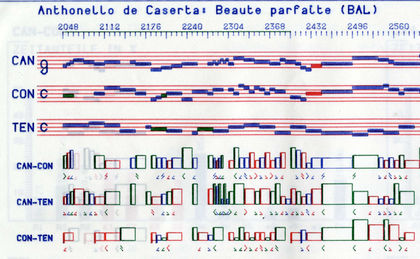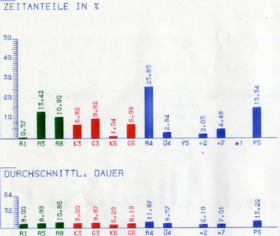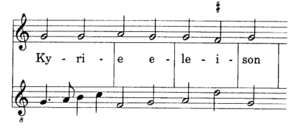Archive of Digital Applications in Musicology (ADAM): Difference between revisions
No edit summary |
|||
| (31 intermediate revisions by 2 users not shown) | |||
| Line 1: | Line 1: | ||
<b>Archive of Digital Applications in Musicology</b> | |||
The aim of ADAM is to preserve information about projects in digital musicology that were ground-breaking in their time but lack a substantial online presence. Projects end for a variety of reasons | The aim of ADAM is to preserve information about projects in digital musicology that were ground-breaking in their time but lack a substantial online presence. Projects end for a variety of reasons: discontinuation of funding, insurmountable changes of technology, or the retirement of a director. These projects remain stand-outs for the careful musical thinking that underlies them and the innovative approaches they introduced. | ||
For curated digital and hybrid editions, see [http://eve.ccarh.org EVE: Electronic and Virtual Editions]. Also see | For curated digital and hybrid editions, see [http://eve.ccarh.org EVE: Electronic and Virtual Editions]. Also see | ||
[http://drm.ccarh.org Digital Resources for Musicology]. | [http://drm.ccarh.org Digital Resources for Musicology]. | ||
==Encoding Systems== | ==Encoding Systems== | ||
{{ADAM Encoding Systems}} | |||
==Analysis-oriented projects== | ==Analysis-oriented projects== | ||
{{ADAM Analysis}} | |||
==Encoded score archives== | ==Encoded score archives== | ||
{{ADAM Score Archives}} | |||
<small>Return to [http://drm.ccarh.org Digital Resources in Musicology</small>] | |||
Return to [http://drm.ccarh.org Digital Resources in Musicology] | |||
Latest revision as of 23:21, 28 October 2016
Archive of Digital Applications in Musicology
The aim of ADAM is to preserve information about projects in digital musicology that were ground-breaking in their time but lack a substantial online presence. Projects end for a variety of reasons: discontinuation of funding, insurmountable changes of technology, or the retirement of a director. These projects remain stand-outs for the careful musical thinking that underlies them and the innovative approaches they introduced. For curated digital and hybrid editions, see EVE: Electronic and Virtual Editions. Also see Digital Resources for Musicology.
Encoding Systems
Digital Alternative Representation of Musical Scores (DARMS)
Website: Digital Alternative Representation of Musical Scores (DARMS)—Historical Documentation
DARMS, the Digital Alternative Representation of Musical Scores, was the result of a pronounced effort to develop a straightforward, inexpensive way to encode musical scores. It's chief protagonists were Stefan Bauer-Mengelberg (code) and Raymond Erickson (documentation and experimentation). Through its summer seminars it stimulated much important thought as to how computers could be used to produce more scores at less cost than ever before. A number of analytical projects, conducted mainly at Yale, explored its uses in investigation music from the Ars Nova to the twentieth century.
Although no new projects are adopting DARMS, one long-in-progress inventory--Printed Sacred Music, which covers a large number of prints from the sixteenth and seventeenth centuries (particularly from Venetian presses), offers access to more than 25,000 titles and 20,000 musical incipits encoded in DARMS.
Fastcode
Website: Fastcode
Fastcode was developed at Princeton University in the mid-1970s by Tom Hall. It was designed particularly with mensural notation in mind. Hall's versatility in developing programs during the mainframe era to meet a wide range of special needs stands as a monument to ingenuity in an era of means we now view as limiting.
Intermediate Musical Language - Music Information Retrieval (IML-MIR)
Website: Intermediate Musical Language - Music Information Retrieval (IML-MIR)
Princeton's Intermediate Musical Language - Music Information Retrieval system, developed between the late 1960s and c. 1975, was intended to facilitate the transcription and analysis such repertories as Renaissance polyphony and Lutheran choral music. (The Bach scholar Arthur Mendel was involved in some of the earliest efforts to analyze Bach's choral harmonizations by computer.) A number of later noted musicologists (and software experts) were extensively involved as graduate students at Princeton University with this work.
LIME: See /TILIA
Mustran
Website: Mustran
Jerome Wenker's Mustran (Music Translator) system was created in conjunction with his doctoral dissertation in computer science (1978) at Indiana University. Like other systems of its time its focus was on producing musical script from a typewriter-model keyboard using only low-order ASCII characters. Initially experimentation was limited to monophonic music, but more sophisticated efforts evolved rapidly at Indiana University, where much other music-related experimentation thrived in the 1970s and 1980s. The most succinct surviving documentation is found in a short undated overview by Rosalee Nerheim.
SMUT
Website: SMUT
Don Byrd's doctoral thesis Music Notation by Computer (Indiana University, 1984) enjoys Biblical status as a compendium of early music transcription systems. it provides great insight into the relations between different systems. Byrd's own System for Music Transcription (SMUT) was a robust one in the 1980s and spawned the desktop notation program Nightingale a decade later.
Teletau
Website: Teletau
The Teletau system was conceived within a multifaceted research project in telematics at the Centro Nucleare Universitario di Calcolo Elettronico (CNUCE) in Pisa, Italy. The center was founded in 1965 and operated under the auspices of the Italian Research Council (CNR in Italy). Pietro Grossi, a cellist and scientist, started the musical informatics program in the same year. The TAU-TAUMUS system was a collection of hardware that facilitated the storage, playback, and manipulation of musical scores. The Teletau manual 1.0 (1986) by Pietro Grossi has kindly been made available by Lelio Camilleri, who joined the project as a student. Camilleri has been professor of composition at the G. B. Martini Conservatory of Music in Bologna, where he heads a program in digital music, since 1999.
TILIA (LIME)
The nucleus of the Tilia music representation system was developed at the University of Illinois in the late 1980s and early 1990s. The associated music-notation program LIME (Lippold's Music Editor) reflected the central role of Lippold Haken (CERL Sound Group) in the design and implementation. Dorothea Blostein (Computing and Information specialist, Queen's University, Kingston Ontario) was co-developer. Because the system was sturdy and extensible, LIME and Tilia have had long continuations in multiple domains of digital activity related to music.
Tilia (in common with MuseData, which originated in the same time-frame) took into account the differing needs of printed materials according to various musical contexts. Any given note or passage could pertain to one of more output configurations such as full scores for symphonies, instrumental parts for teaching and rehearsal, piano reductions, parts, reductions, and so forth.
The impetus for the development of both tools was the PLATO learning system, a comprehensive set of applications intended to serve the needs of diverse communities within the university.
ZIPI
Website: ZIPI
The ZIPI Music Parameter Description Language (MPDL), v. 1.0, developed by Zeta Music systems (until 2011 a supplier of electric violins, cellos, and bass guitars in Oakland, CA) and personnel of CNMAT (UC Berkeley) in the 1990s, was a proposed successor to MIDI, which proved to be a crippled tool in many electronic-music situations. Keith McMillen, David Wessel, and Matthew Wright were its developers. It addressed such issues as brightness, articulation, and the inability of MIDI to treat series of notes as a group. MPDL was the first tier of an conjectured system in which other capabilities could be added. Like MIDI, ZIPI was a message-based system, as it was intended to work exclusively in interactive contexts. Unlike MIDI (an 8-bit system), it was a 16-bit system. Thus it could accommodate a much larger palette of virtual instruments and timbres. It could also provide support for more finite semitones than MIDI's equal-tempered half step. MIDI note numbers were embedded in a ZIPI byte. ZIPI also supported input from string (bowed or plucked) and wind instruments, so that those wishing to "record" their works were not limited to an electronic keyboard. Its network protocols would have enabled more than 200 devices (connected peer-to-peer) to collaborate. An early version of its manual is available ZIPI here.
Analysis-oriented projects
Essen Associative Code (EsAC)
Website: EsAC: Goals, History, Manuals
The Essen Associative Code for folk-song research was actively maintained by its developer, Helmut Schaffrath (1942-1994), and, after his death by Ewa Dahlig. Its encoded materials are now mainly used (after translation to other codes) to test algorithms for melodic search and folksong analysis. The software developed by Schaffrath and his collaborators was particularly intended to observe conventions of traditional-music research, including adherence to strict rules for phrase segmentation (based on underlying texts) and a freedom of restrictions in defining scales and "tonalities". Lyrics are not normally contained within EsAC music encoding, but an exception was made for some Norwegian and Polish folksongs. In these cases adaptations of the code were required to accommodate multiple syllables sung on one pitch (and the reverse). (Conventional EsAC is strictly monophonic and the addition of lyrics in essence creates a second stream of information.) While little new encoding in EsAC has occurred over the past decade, several large corpora of nineteenth-century typescript encodings of folksongs in Central Europe suggest that preservation of a knowledge of EsAC is essential to the interests of future ethnography.
Research of Norbert Böker-Heil
Website: Norbert Böker-Heil

The German systematic musicologist Norbert Böker-Heil carried out numerous trials of computer-assisted research in multiple German locations in the 1970s and 1980s. Seizing every opportunity to explore mainframe computer use for musicological purposes, he delved into music printing, database development, and music analysis, always with a focus on repertories of the later middle ages and early Renaissance. Apart from his noted multi-volume survey of sources for the Tenorlied (1979-1988) and his collaborations with other scholars on the integration of textual and musical information, he explored computer-driven sound synthesis (1983) before the establishment of MIDI protocols; outlined the computer possibilities of the RISM AII (manuscript inventory) project (1975) two decades before there was public access to the internet; developed a system for input and plotter output of white mensural notation (1971); producing a near facsimile of the original notation; sought to develop a tool to automatically identify musical structure in polyphonic music (1972); and help up a beacon to future researchers in his thoughts on problems that computer-based researcher would encounter as machine capabilities improved.

Among his most sophisticated projects were the color-coded music-analysis tools he developed for fourteenth-century music in his later years at the Staatliches Institut für Musikforschung in Berlin. From his substantial, multi-faceted evaluations of particular Tenorlieder we are able to reproduce this series of images from his work on Anthonello de Caserta's "Beaute parfaite". The composer came from the generation following Machaut and lived around 1500. Böker-Heil explores (1) rhythmic and pitch movement in this three-voice work and the kinds of intervals that occur between voices; (2) the three-part harmonies that occur in specified time-slices; and (3) contrapuntal details deriving average duration and phrase length. (Each "view" consists of two panels, as there was no way at the time to scale output.)
Encoded score archives
Werner Icking Music Archive (WIMA)
Website: Werner Icking Music Archive
The recent history of the Werner Icking Music Archive. Icking and several colleagues developed a music-printing capability that was modeled on the TeX metafont and typesetting system. He built an online capability for users to share scores they had edited and typeset themselves. In many cases this included full sets of parts. Some editions were arrangements. MusiTeX (and related dialects) were often traded within the community, but some of the contributions predated the widespread use of the internet. After Icking's death (2001), his archive was administered by a contributor, Christian Mondrup. In 2011-12 it was amalgamated with the IMSLP aggregation. Icking offered an important prototype for current score-interchange sites.
Emerging Desktop Notation Systems of the 1980s and 1990s
The Center for Computer Assisted Research in the Humanities distributed an annual survey to notation-software developers. Examples of specific challenges in notation software were provided. This was a period of rapid change in printing and computer computer technology, as well as operating systems. Nothing stayed the same for long. At its peak the solicitation drew 88 respondents who were eager to show off their latest capabilities. Methods for reproducing their submission, with integrated text and graphics, lagged somewhat behind. Edmund Correia Jr. (a pianist) coordinated the submissions and supervised reproduction of the examples.
In 1994 the IEEE Computer Society published a resume of specific problem types and selected contributions. We made our final solicitation in 1996. By then the dynamism of the field was starting to fade, and a few commercially funded programs began to dominate. We show here a selection of materials as originally submitted. (Some are labeled with details of the printing system used.)
- Amadeus at its best produced elegant notation of limitless complexity based in Poeking, DE. (Output was scalable to 1000 dots per inch.) It was a stand-alone system that traced its origins to the Atari Mega ST4. Kurt Maas was the designer.

- Calliope, graphics-based program developed in the Cambridge Computing Laboratory by William Clocksin, ran on the NextStep operating system. It offered support for early music, lute tablature, and chant repertories.
- Common Music Notation (CMN), a LISP-based program by Bill Schottstaedt, was developed at the Center for Computer Research in Music and Acoustics (CCMRA) at Stanford University. Composers using LISP and Heinrich Taube's Common Music were the principal users.
- Dai Nippon Music Processor was developed by the Dai Nippon Printing Company LTD om Ichigawa, JP. Alphanumeric input code was output to MIDI instruments, PostScript printers, a Digiset typesetter, and the Standard Music Expression (SMX) file format, which was principally exchanged with a research group at Waseda University. Featured in from 1988 to 1992.
- DARMS-based systems. DARMS, a print-oriented representation system, stimulated many project ideas (see in ADAM). The longest surviving implementations we know of were Lute Code and the Note Processor, the first one related to the second. The Note Processor, a PC-based program by Stephen Dydo, was in active use from the late 1980s to the mid-90s. Frans Wiering's Lute Code c1990 facilitated the printing of lute tablature from Italy and France with The Note Processor, listed below. See also MusE.
- Graphire Music Press of Wilder, VT, was a high-end system by Alan Talbot, who also developed the Synclavier Music Engraving System. Graphire MP supported line-art graphics, provided a page-layout program, and employed a notation expert system. It offered special provisions for shape-note and handbell notation and well as the ability to combine different kinds of notation in one score. Its primary uses were commercial.
- LIME, or Lippold's Music Editor, was developed Lippold Haken (University of Illinois) and Dorothea Blostein (Queen's University, Kingston, ON) c1991. A multifaceted complex of programs, LIME supported PostScript imaging devices and on-demand printing. At its peak more than 110,000 copies in distribution. The graphical editor was used in NovaNet (PLATO) teaching applications, and it was foundational in the development of programs for unsighted musicians by Dancing Dots (Valley Forge, PA). In recent years Haken has developed the Continuum Keyboard.
- MUP, a music-printing program by John Ark and William Krauss, was an ASCII-based music-formatting system intended for automatic layout.
- MusE, a proprietary DARMS implementation developed by Tom Hall for A-R Editions, Middleton WI, is a heavy-duty system with numerous extensions for special notations. It has been the backbone of A-Rs substantial contributions to otherwise unavailable repertories. A licensible version, Music Engraver (HB Music Engraver), was available for many years.
- Music Manuscriptor was a commercial software system developed by Erato Software Corp., Salt Lake City UT. It was used for composition, orchestration, and generating film scores from sketches.
- MusicTeX (also MusiTeX, MuTeX) was the backbone of the collaboration known as the Werner Icking Music Archive (see ADAM), which is now absorbed into the IMSLP (International Score Music Library Project). MusicTeX consisted of sets of macros, fonts, and programs for music-typesetting compatible with Donald Knuth's TeX typesetting program.
- Nightingale, Don Byrd's notation system for Macs, supported multiple methods of input, display, and playback. Its aim was to give users control over every aspect of musical scores.
- The Note Processor, Stephen Dydo's DARMS-based notation software, was designed for PCs. It made generous provisions for music composed in the later twentieth century.
- Noteability, a sibling of NoteWriter, emphasized graphical flexibility (a rarity for the time). It operated on PCs and Next (NextStep) machines (v. 3.3 or higher).
- NoteWriter was a PostScript-compatible Mac-based program and successor to MusScribe with a strong focus on twentieth-century notation and analytical examples for scholarly journals. Keith Hamel (Vancouver) was its developer.
- Personal Composer was a PC-based program integrating notation, printing, and music sequencing. It enabled print controls that were rare for the time.
- Philip's Music Scribe, developed by Philip Hazel (Cambridge UK) for the British Acorn Archimedes computer, was distributed throughout the English-speaking world excluding North America. A PostScript-compatible program, its special features included coordinated creation of scores and parts and two-stave reductions from four-voice choral music.
- Rhapsody, a predecessor of Encore, was announced by Passport Designs (Foster City CA) but has been invisible since the mid-90s.
- SCORE, Leland Smith's industrial-strength program for the typesetting of musical scores, was developed (1972) at Stanford University's first artifiical intelligence lab on a mainframe computer (PDP 11) with output to a plotter. In existed in a DOS-based conversion from the early 80s until c2020. Over time it transitioned to PCs. Although it always ran most smoothly in FORTRAN, a Windows version was available in the 2000s. SCORE served as a backbone of the collected editions of many composers of the nineteenth and twentieth centuries (Schoenberg, Verdi, Wagner. et al.) in the editions of Bärenreiter and Schott. SCORE was known for the esthetic appeal of its scores, its numerous libraries of special symbols (e.g. for harp and drum notation), and its ability to integrate lyrics in non-Roman characters into its scores. Several companion programs included FinalScore for conversion from Finale and MIDISCOREWRITE were in use in the 90s.
Return to Digital Resources in Musicology